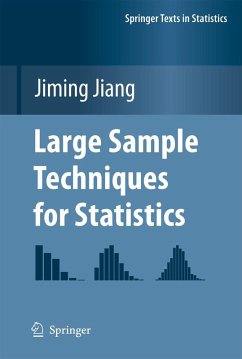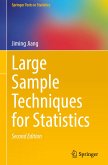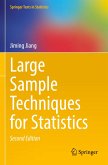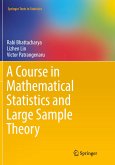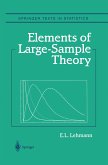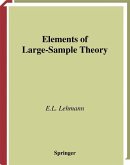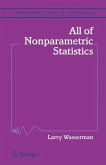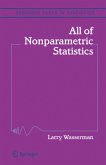This book offers a comprehensive guide to large sample techniques in statistics. More importantly, it focuses on thinking skills rather than just what formulae to use; it provides motivations, and intuition, rather than detailed proofs; it begins with very simple techniques, and connects theory and applications in entertaining ways. The first five chapters review some of the basic techniques, such as the fundamental epsilon-delta arguments, Taylor expansion, different types of convergence, and inequalities.
The next five chapters discuss limit theorems in specific situations of observational data. Each of the first 10 chapters contains at least one section of case study. The last five chapters are devoted to special areas of applications. The sections of case studies and chapters of applications fully demonstrate how to use methods developed from large sample theory in various, less-than-textbook situations.
The book is supplemented by a large number of exercises, giving the readers plenty of opportunities to practice what they have learned. The book is mostly self-contained with the appendices providing some backgrounds for matrix algebra and mathematical statistics. The book is intended for a wide audience, ranging from senior undergraduate students to researchers with Ph.D. degrees. A first course in mathematical statistics and a course in calculus are prerequisites.
In a way, the world is made up of approximations, and surely there is no exception in the world of statistics. In fact, approximations, especially large sample approximations, are very important parts of both theoretical and - plied statistics.TheGaussiandistribution,alsoknownasthe normaldistri- tion,is merelyonesuchexample,dueto thewell-knowncentrallimittheorem. Large-sample techniques provide solutions to many practical problems; they simplify our solutions to di?cult, sometimes intractable problems; they j- tify our solutions; and they guide us to directions of improvements. On the other hand, just because large-sample approximations are used everywhere, and every day, it does not guarantee that they are used properly, and, when the techniques are misused, there may be serious consequences. 2 Example 1 (Asymptotic? distribution). Likelihood ratio test (LRT) is one of the fundamental techniques in statistics. It is well known that, in the 2 "standard" situation, the asymptotic null distribution of the LRT is?,with the degreesoffreedomequaltothe di?erencebetweenthedimensions,de?ned as the numbers of free parameters, of the two nested models being compared (e.g., Rice 1995, pp. 310). This might lead to a wrong impression that the 2 asymptotic (null) distribution of the LRT is always? . A similar mistake 2 might take place when dealing with Pearson's? -test-the asymptotic distri- 2 2 bution of Pearson's? -test is not always? (e.g., Moore 1978).
The next five chapters discuss limit theorems in specific situations of observational data. Each of the first 10 chapters contains at least one section of case study. The last five chapters are devoted to special areas of applications. The sections of case studies and chapters of applications fully demonstrate how to use methods developed from large sample theory in various, less-than-textbook situations.
The book is supplemented by a large number of exercises, giving the readers plenty of opportunities to practice what they have learned. The book is mostly self-contained with the appendices providing some backgrounds for matrix algebra and mathematical statistics. The book is intended for a wide audience, ranging from senior undergraduate students to researchers with Ph.D. degrees. A first course in mathematical statistics and a course in calculus are prerequisites.
In a way, the world is made up of approximations, and surely there is no exception in the world of statistics. In fact, approximations, especially large sample approximations, are very important parts of both theoretical and - plied statistics.TheGaussiandistribution,alsoknownasthe normaldistri- tion,is merelyonesuchexample,dueto thewell-knowncentrallimittheorem. Large-sample techniques provide solutions to many practical problems; they simplify our solutions to di?cult, sometimes intractable problems; they j- tify our solutions; and they guide us to directions of improvements. On the other hand, just because large-sample approximations are used everywhere, and every day, it does not guarantee that they are used properly, and, when the techniques are misused, there may be serious consequences. 2 Example 1 (Asymptotic? distribution). Likelihood ratio test (LRT) is one of the fundamental techniques in statistics. It is well known that, in the 2 "standard" situation, the asymptotic null distribution of the LRT is?,with the degreesoffreedomequaltothe di?erencebetweenthedimensions,de?ned as the numbers of free parameters, of the two nested models being compared (e.g., Rice 1995, pp. 310). This might lead to a wrong impression that the 2 asymptotic (null) distribution of the LRT is always? . A similar mistake 2 might take place when dealing with Pearson's? -test-the asymptotic distri- 2 2 bution of Pearson's? -test is not always? (e.g., Moore 1978).
From the reviews:
"Each chapter is supplemented by a series of exercises. ... The book clearly helps the beginner to learn the foundations and techniques of large sample theory in statistics in part one, provides an outline of more advanced tools in part two and gives an impressions of the flavor of their applicability in part three. It is very suitable as a survey of and a guide to the addressed topics ... ." (Erich Haeusler, Mathematical Reviews, Issue 2011 k)
"Jiming Jiang's book on large sample techniques is a very welcome addition to the literature. Its strong points include the breadth of covered material, choice of relevant and interesting topics, lucid and attractive style of presentation, and sound pedagogical aspects. ... Along with its excellent coverage of the fundamentals in its initial chapters, the book addresses a number of important topics in the latter half as well. ... All in all, Large Sample Techniques in Statistics is an excellent book that I recommend whole-heartedly." (Moulinath Banerjee, Journal of the American Statistical Association, Vol. 106 (496), December, 2011)
"A book on techniques for large samples in statistics is timely. ... Anyone with a background in ... mathematical statistics can benefit from the very thorough nature of the book. The author is systematic and detailed in the developing of each topic and utilizes examples and cases to illustrate the practical import of each concept. ... I found the book quite enlightening as the author again and again pointed out the confusions and misinterpretations that often arise in the context of common applications ... ." (Mark A. McComb, Technometrics, Vol. 54 (1), February, 2012)
"Each chapter is supplemented by a series of exercises. ... The book clearly helps the beginner to learn the foundations and techniques of large sample theory in statistics in part one, provides an outline of more advanced tools in part two and gives an impressions of the flavor of their applicability in part three. It is very suitable as a survey of and a guide to the addressed topics ... ." (Erich Haeusler, Mathematical Reviews, Issue 2011 k)
"Jiming Jiang's book on large sample techniques is a very welcome addition to the literature. Its strong points include the breadth of covered material, choice of relevant and interesting topics, lucid and attractive style of presentation, and sound pedagogical aspects. ... Along with its excellent coverage of the fundamentals in its initial chapters, the book addresses a number of important topics in the latter half as well. ... All in all, Large Sample Techniques in Statistics is an excellent book that I recommend whole-heartedly." (Moulinath Banerjee, Journal of the American Statistical Association, Vol. 106 (496), December, 2011)
"A book on techniques for large samples in statistics is timely. ... Anyone with a background in ... mathematical statistics can benefit from the very thorough nature of the book. The author is systematic and detailed in the developing of each topic and utilizes examples and cases to illustrate the practical import of each concept. ... I found the book quite enlightening as the author again and again pointed out the confusions and misinterpretations that often arise in the context of common applications ... ." (Mark A. McComb, Technometrics, Vol. 54 (1), February, 2012)

